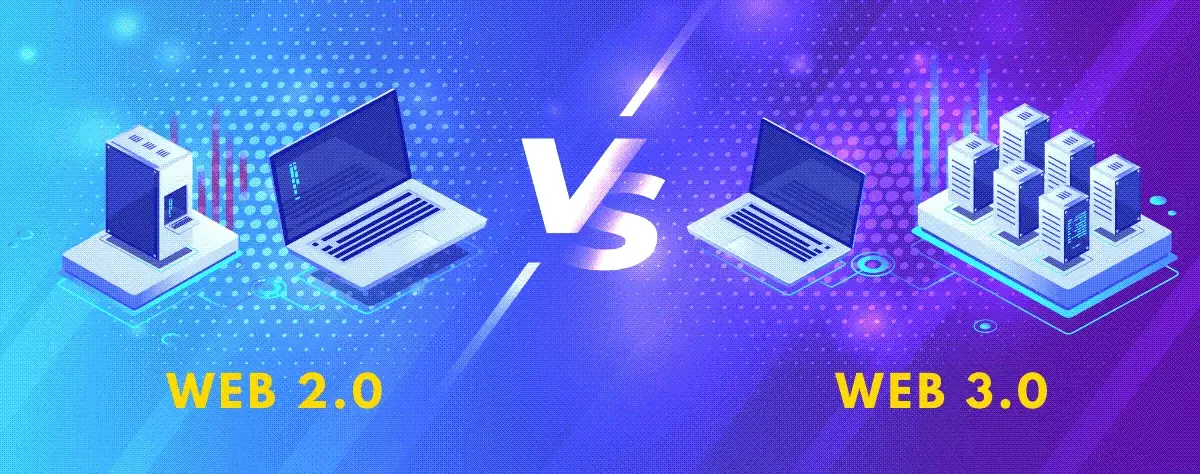Web 2.0 vs. Web 3.0: A Comprehensive Comparison
by
-
5 minutes read
-
March 30, 2021

Introduction
The evolution of the internet has transformed the way we interact, communicate, and conduct business. Two significant phases of this transformation are Web 2.0 and Web 3.0. While Web 2.0 introduced user-generated content and interactivity, Web 3.0 takes decentralization and blockchain technology to new heights. In this blog, we will delve into the detailed comparison between Web 2.0 and Web 3.0, exploring their key features, benefits, and potential impacts on various industries.
Web 2.0: Enabling User Interaction and Collaboration
Web 2.0, often referred to as the ‘Social Web‘ emerged in the early 2000s and marked a paradigm shift from the static and one-way communication of Web 1.0. It introduced dynamic websites and platforms that enabled user-generated content, fostering collaboration and interaction. Key characteristics of Web 2.0 include:
- User-Generated Content: Web 2.0 platforms allowed users to create, share, and contribute content, giving rise to social media, blogs, wikis, and video-sharing platforms.
- Interactivity: Websites became more interactive, enabling real-time communication, commenting, and feedback, enhancing user engagement.
- Rich User Experience: Advances in front-end technologies led to more visually appealing and user-friendly interfaces, contributing to a better overall browsing experience.
- Social Networking: Social media platforms like Facebook, Twitter, and LinkedIn gained prominence, facilitating global connectivity and communication.
- Cloud Computing: Web 2.0 paved the way for cloud-based services, enabling easy access to data and applications from anywhere with an internet connection.
Web 3.0: Decentralization and Beyond
Web 3.0, often referred to as the ‘Semantic Web‘ or ‘Decentralized Web‘ represents the next phase of internet evolution. It builds upon the foundation of Web 2.0 but introduces revolutionary concepts driven by blockchain technology. Key features of Web 3.0 include:
- Decentralization: At the core of Web 3.0 is the decentralization of data and applications, powered by blockchain and distributed ledger technology. This eliminates the need for central intermediaries and enhances security and privacy.
- Smart Contracts: Web 3.0 introduces smart contracts, self-executing contracts with the terms directly written into code. These contracts automate processes, ensure transparency, and eliminate the need for intermediaries.
- Tokenization: Blockchain-based tokens enable digital ownership and represent real-world assets. This has led to the rise of Non-Fungible Tokens (NFTs) and new possibilities in areas like digital art, collectibles, and even real estate.
- Semantic Understanding: Web 3.0 aims to enhance machine understanding of data by providing context and meaning to information, resulting in more precise search results and personalized experiences.
- Privacy and Security: With data ownership and control being transferred to users, Web 3.0 prioritizes privacy and security, reducing the risks of data breaches and unauthorized access.
Comparative Analysis
- Data Control and Ownership:
- Web 2.0: Centralized platforms often retain control and ownership of user data, raising concerns about data privacy and monetization without user consent.
- Web 3.0: Users have greater control over their data through decentralized applications (DApps) and blockchain, determining how and where their data is used. - Intermediaries:
- Web 2.0: Central intermediaries facilitate transactions, content distribution, and interactions, potentially leading to censorship and single points of failure.
- Web 3.0: Decentralization eliminates the need for intermediaries, promoting peer-to-peer interactions and reducing censorship risks. - Monetization and Economy:
- Web 2.0: Monetization strategies often rely on advertising revenue and centralized payment gateways.
- Web 3.0: Tokenization and decentralized finance (DeFi) enable new monetization models, allowing direct transactions between users and content creators. - Innovation and Collaboration:
- Web 2.0: Collaboration and innovation are largely confined to platform boundaries.
- Web 3.0: Open-source nature and interoperability of blockchain technology foster cross-platform collaboration and innovation. - User Experience:
- Web 2.0: User experience depends on platform design and functionality, with potential for information overload.
- Web 3.0: Semantic understanding and AI-driven personalization enhance user experiences by delivering relevant and context-rich content.
Impacts on Industries
- Finance:
- Web 3.0 introduces decentralized finance (DeFi), reshaping traditional financial systems, enabling peer-to-peer lending, and reducing reliance on banks. - Art and Entertainment:
- NFTs on Web 3.0 revolutionize digital art ownership and distribution, empowering artists and collectors. - Supply Chain and Logistics:
- Web 3.0 enhances transparency and traceability, mitigating supply chain fraud and ensuring product authenticity. - Healthcare:
- Patient data on Web 3.0 can be securely stored and shared, enabling seamless and secure health data exchange. - Education:
- Decentralized educational platforms on Web 3.0 allow for verified credentials and customized learning experiences.
Conclusion
The transition from Web 2.0 to Web 3.0 represents a monumental shift in the way we interact, transact, and utilize the internet. Web 3.0‘s emphasis on decentralization, data ownership, and blockchain technology holds the promise of revolutionizing multiple industries and providing users with unprecedented control over their digital lives. While Web 2.0 brought user-generated content and interactivity to the forefront, Web 3.0 takes these concepts to a new level, paving the way for a more secure, transparent, and user-centric digital future. As Web 3.0 continues to evolve, its impacts on various sectors and society as a whole are poised to be profound and far-reaching.